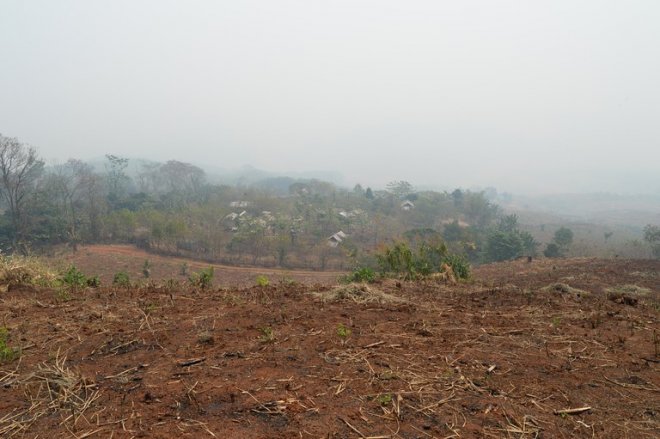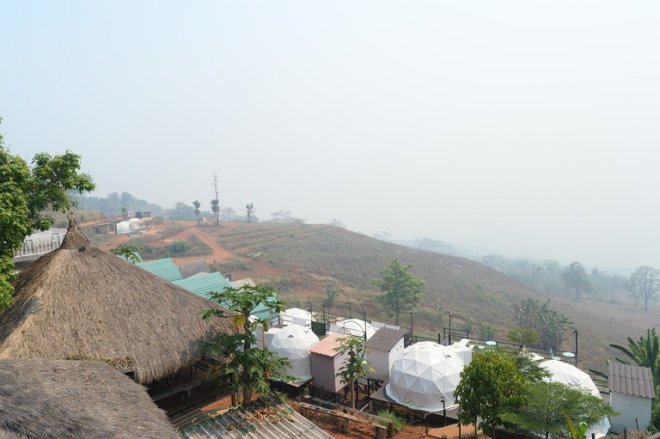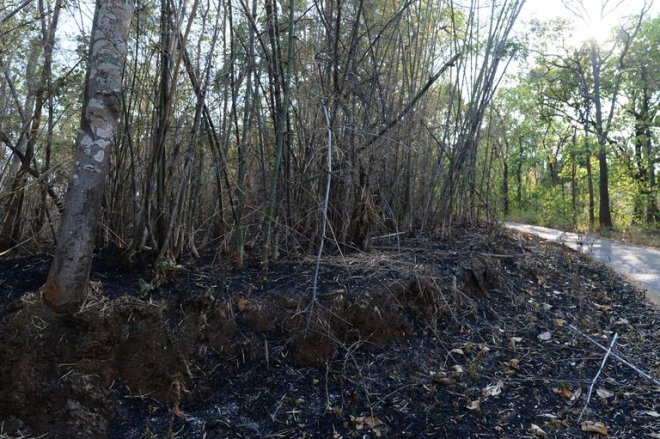Culprits behind dense smog in northern Thailand, Laos: Corn and wildfires
It was almost midnight, and the full moon appeared an eerie burnt orange above the streetlights that were clouded by the smog hanging in the air.“Our nose burns, our throats get stuck and our eyes turn teary. It has been this way since February,” said Phattanik Masa, a resident of Mae Sai, in northern Thailand, who was wearing two face masks as she stood in line with others to offer alms to monks.
“This Buddhist ceremony is a significant event. We do it for good luck,” she explained. “That’s why we are all here despite the horrible air.”
For the past two months, residents across northern Thailand and Laos as well as Shan state in Myanmar have been suffering from the worst smog in years.
Thousands have gone to hospitals with respiratory problems, and workers in Chiang Mai, Thailand – ranked among the most polluted cities in the world in recent weeks – have been told to stay indoors and work from home.
The two main culprits behind the hazardous pollution – 16 times worse than healthy levels in some areas – are out-of-control wildfires and the burning of ever-wider fields of corn stubble after the February harvest to clear land for planting season in May.
The wildfires are fanned by drier-than-usual weather. Many are in hilly, inaccessible areas and Thailand’s fire-fighting efforts are under-funded.
Farmers, meanwhile, have carved growing swathes of farmland from the forest to raise corn, grown mostly for animal feed. Demand for meat is increasing, which means greater demand for corn – and higher prices, which drives the farmers to plant, grow and burn more.
“The situation is the culmination of many years of bad agricultural practice,” said Rattanasiri Kittikongnapang, a Greenpeace food and ecology campaigner. “This is the worst haze in more than 10 years.”
Unenforced zero-burn policy
Corn fields are spreading all over the region. Between 2015 and 2019, 1.7 million hectares of land was converted from forest to maize cultivation, she said.
The Thai government announced a zero-burn policy in March, but it has not been enforced. Authorities in Bangkok are “hoping it will all go away by itself since they are getting ready for an election,” said Rattanasiri.
 A maize field that was burned after the harvest is seen in Doi Sa-Ngo village in Chiang Rai province in northern Thailand, April 5, 2023. Credit: Subel Rai Bhandari for RFA
A maize field that was burned after the harvest is seen in Doi Sa-Ngo village in Chiang Rai province in northern Thailand, April 5, 2023. Credit: Subel Rai Bhandari for RFAAchoo, a Thai farmer with corn fields in Doi Sa-Ngo village in Chiang Rai province, sees no problem with burning. “It’s natural. After you collect the harvest, you burn the rest,” she said. “Everyone does this, and we have been doing this for years.”
But there are economic forces at work here, too.
Previously, villagers grew mostly vegetables, cassava, pineapple and edible flowering plants. In recent years, they have switched to maize, especially after one of the farmers became a middleman to transport it to animal feed companies.
“We don’t have to do anything. We get seeds and fertilizers from this person, even if we don’t have any money,” Achoo said. “After the harvest, he collects it from us and takes it to the city.”
The growing number of so-called hot spots – areas where fires burn or are likely to burn – are linked to deforestation and growing more corn for animal feed. And the increasing demand for corn can be linked directly to the expansion of the meat industry, says Alliya Moun-Ob, an air pollution campaigner for Greenpeace Thailand.
According to government figures, Thailand needs at least 8 million tonnes of maize for animal feed but produces about 5 million tonnes. It means the rest has to be imported.
Corporate demand
Two decades ago, Thailand set up cross-border contract farming programs with farms in Laos, Myanmar and Cambodia under which it imports corn at zero tariffs. Since then, the region has spiked in open burning, Alliya said.
Alliya and other activists say much of the demand for corn is driven by Thailand’s Charoen Pokphand Group, or CP Group, the world’s largest animal feed producer, with an annual production of 27,650 metric tons.
 Haze obscures the mountains as seen from Doi Sa-Ngo village in Chiang Rai province in northern Thailand, April 5, 2023. Credit: Subel Rai Bhandari for RFA
Haze obscures the mountains as seen from Doi Sa-Ngo village in Chiang Rai province in northern Thailand, April 5, 2023. Credit: Subel Rai Bhandari for RFA“The Thai government supports one particular company - CP - which is responsible for contract farming maize in the north and neighboring countries,” Rattanasiri said.
To convince rice farmers to switch to corn, CP said it would provide interest-free financial support, if needed, and promised it would buy the product at a guaranteed price in a pilot program announced in December by the Royal Initiative Discovery Institute, a palace project promoting sustainable agriculture in the countryside.
Many farmers “who don’t have any resources or capacity, also don’t have a choice” but to do contract maize farming, Alliya said.
“What is missing in legal and policy-making mechanisms is the liability of industrial sectors linked to environmental impacts while gaining benefits from maize,” Alliya said.
CP says it is implementing a program to trace and verify if its source of maize for feed production is cultivated in a sustainable manner, including from areas that were not deforested and farms that do not resort to burning the stubbles.
Paisarn Kruawongvanich, a company executive, said the group has “always prioritized building a sustainable food production chain while also mitigating transboundary haze pollution.”
CP did not respond to an RFA question about what it would do if farmers failed to follow their advice to stop burning stubble.
The increasing demand for livestock feed has been lifting corn prices. In February, local corn prices were 26% higher than a year ago, according to the U.S. Department of Agriculture Foreign Agricultural Service grain and feed report, “due to insufficient locally produced corn and uncertainty in the global corn trade.”
Wildfires
Apart from that, wildfires are burning wildly out of control in many parts of the region this year, experts said, due to the start of the dry season after the end of La Nina, in which low sea surface temperatures in the equatorial Pacific Ocean results in cooler and wetter conditions in parts of Asia.
In Laos, air quality has remained “unhealthy” to “hazardous” for over four weeks. IQAir said the PM2.5 concentration in the capital Vientiane on Friday was 150, more than 11 times the WHO guideline.
Residents told RFA Laos Service the smoke was coming from all directions, as experts blamed open burning and weather changes for this year’s fire problem.
“The visibility is low. We have to wear masks when going outside. My kids are getting sick and have itchy noses and eyes. It’s like having a cold or flu,” a resident of the capital Vientiane told RFA’s Lao Service earlier this month.
A doctor at a Vientiane hospital said they were receiving “a lot of patients with respiratory problems.”
In Myanmar’s Shan state, residents in Tachileik, which borders Mae Sai, told RFA’s Myanmar Service they had been badly affected by smog since Mar. 24, forcing flights to be canceled.
Local residents said that in the past, the haze lingered for a couple of days, but this time it has been longer and denser.
In Southeast Asia, El Nino – warmer ocean surface temperatures – brings drier, warmer weather and increases the risk of forest fires and smoke haze, according to the ASEAN Specialized Meteorological Center, or ASMC.
“There was also likely no controlled burning management to maintain the forest’s health. If you don’t manage it properly, a small fire could easily be huge and uncontrolled,” said Prof. Ekbordin Winijkul, head of the energy, environment, and climate change department at the Asian Institute of Technology,
 A wildfire destroyed this roadside forest located on the way to Doi Chang mountain in Lamphun province, Thailand, April 4, 2023. Credit: Subel Rai Bhandari for RFA
A wildfire destroyed this roadside forest located on the way to Doi Chang mountain in Lamphun province, Thailand, April 4, 2023. Credit: Subel Rai Bhandari for RFAThai authorities would not say the suspected causes for wildfires, though many people have been arrested for suspicion of starting the fires.
Activists told RFA that the reasons could be to clear forests to create new farmland or for mushroom-hunting. The destruction caused by the fire creates a nutrient-rich environment conducive for fungi to grow almost immediately afterward, which farmers hunt to collect and sell in the market.
If nothing is done about addressing the smog, more people will die, experts say
Air pollution was among the top 10 risk factors for death in all Southeast Asian countries in 2019, with about half a million premature deaths attributed to exposure to air pollution, said Mushtaq Memon, UNEP Coordinator of Chemicals and Pollution Action for Asia and the Pacific.
“Immediate challenges on addressing the open burning of crop residues include providing timely and sufficient resources” to farmers, he said.
Ekbordin said transboundary haze “is not one country or one company problem.”
“We must address it collectively. If we do not take concrete actions soon, then the situation will worsen,” he added. “And it will happen every year.”
|
本篇 |
不想錯過? 請追蹤FB專頁! |
| 喜歡這篇嗎?快分享吧! |
相關文章
AsianNewsCast
























